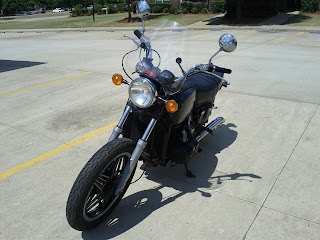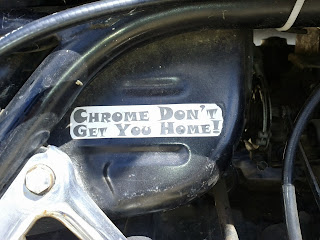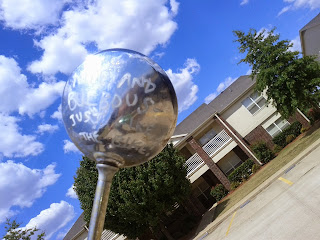I had been shopping for a kayak for some time. Unfortunately where I live floating the river, and kayaking in particular, had become the "in" thing to do, and to buy a used kayak was almost as expensive as a new one. I happened to stumble across something I hadn't considered.
Building a kayak.
Always being one to do things myself, I was immediately hooked. I pored over countless web pages, absorbing information and deciding what I wanted. Strip built? Stitch and glue? Skin-on-frame? What could I get by with the cheapest? What would be the easiest? Fastest to get together? I finally settled on The Old Man's River Ranger 12, using some
plans I found that I thought would be the easiest, fastest, cheapest to build. It comes in the 12' version (that I built), a 14' version, and a 16' version. I think I may build the 14' version next, just to get a little bit more storage and float a little higher I could find very few references to it anywhere online, and only one
build thread. I had to have one, and no one knew what I was talking about. This is the picture that made me finally decide (although I don't think it's a RR):
So I got together a list of materials and waited for payday. I decided I needed to have an elevated surface to build on, so I made some saw horses and pieced together a 16' long table so I could scarf together the wood and be working with one large piece. Couldn't have worked better.

Then I set about making my scarf joint to make one long 16'x4' sheet of plywood. I used
5mm project sheets from Lowes. The scarf joint was the most time-consuming part of the whole project, although that probably has to do with the fact I did it by hand with a rasp and block sander. If I had a belt sander, I'd put some coarse-grit paper on it and be done in a jiffy. Next time. I staggered the top sheet 2" back from the bottom sheet (making the similar sides face each other so I'd have the same grain pattern the whole length), and made a mark 2" back from the edge of the top sheet. Then I planed/sanded the whole 4" wide area into one smooth angle. Then, I flipped the top sheet back over, lined up the sheets so they were overlapping on the 2" (using small nails to secure them n place) and glued them with the
epoxy resin, using wax paper to keep it from sticking to the table and the 2x4 I used to apply pressure to the top.



Once that dried overnight, I started laying out the patterns for my pieces. I put my keel plate in the middle against one edge, each side piece on either side of it, and then had plenty of area on the far end to make my deck plates and bulkheads. I used small nails along the lines and a small piece of trim to make the dots from the plans line up into an even curve (the plans come with drawings of the pieces, with dots with coordinates you have to draw lines between). Once I had all my pieces laid out, I picked up a jigsaw and went to town. From my experience with a "quick cut" blade with few teeth, I suggest using a finer-toothed blade to reduce splitting as you cut.
Once I made sure everything was going to line up, I stitched the pieces together with small zip ties. I simply used a small drill bit to make holes that lined up on each panel, then zipped them together. It was starting to look like a boat!
I made the fillets (thickened glue along the edges of mating panels to glue them together) out of the epoxy thickened with flour. Wood flour (finely ground wood) would have been ideal, but I found a couple of different places that said bread flour would be acceptable. I'll warn you since no one warned me: it will take a lot of the flour to thicken the epoxy to peanut-butter texture. I couldn't ever get it there before the epoxy started to set and gel up so I half-assed the fillets.

Then, it was time to sand. And sand. And sand. And take a break. And sand. Once I had all the panels adequately smooth (again, I half-assed it but it was good enough for me), I laid the fiberglass cloth down and smoothed it out on the outside of the hull. I wanted to pick up some good cloth, but funds, time, and impatience added up to me laying individual sheets of
fiberglass cloth, again from Lowes. I covered the cloth with a first layer of resin and waited for it to dry. Again, being the cheap bastard I am, I cheaped out on the resin and got the cheap stuff. From Lowes. I also only glassed the outside of the hull, and only put one layer of resin down. On the next one I do, I'll do it like it should be done and put 3-4 layers of resin and glass the whole thing, inside and out. Do as I say, not as I do. Then I put 4 layers of
varnish on the outside of the hull and turned my efforts toward the inside.


To bend the 1x3's I used as gunwales, I cut out a 2x4 and clamped the ends together. I had several ideas for a seat, but I decided to just have a couple of 2x2 sections that a canoe seat hooked onto. It didn't work at all, and would only last for one outing before I rigged up a better seat. I glued in small pieces of 2x2 in the front and back storage sections. They look kind of funny, but you'll see why they're there shortly. I used small pieces of 2x2 glued to the walls to mount the foot rests, as you'll see soon.




I pieced together the decks by laying down wax paper, setting them together, and laying a sheet of fiberglass over them. I resined over them and waited for the resin to begin to set, and then put the decks over their places on the front and back to shape them, and clamped them down with ratchet straps, again with wax paper on top and around the edges to keep the epoxy from sticking them in place. The plans called for these to be glassed in place and holes cut in them for hatches, but I decided to make the whole panels themselves the hatches. Worked much better and was much easier in my humble opinion. Once the glass was dry I varnished over them to make 'em shiny.

I varnished the entire inside of the boat with 3 layers, and then set about putting the finishing touches on it. I cut pieces of OSB to line the inner edges of the hatches to support the decks. I used foam-rubber window weatherstripping along the top edges to create a seal. I got my
deck rigging setup to bungee the hatches on and provide attachment points for various other features, like the paddle holder and front and rear storage I made inside the hatches.
Every time I go floating, someone loses a paddle. So I put the blocks in the front to hold an emergency paddle in place. The blocks in the back are spaced to hold down 2 large dry boxes. The red one is my first aid kit, and I mostly use the clear one to store my phone, wallet, and bluetooth speaker when I'm not using it.
Once I got the bungees hooked up to hold on the decks, she was ready to get wet. Now she just needed a maiden voyage
I wanted to add cleats to the front for a bungee net (the biggest reason for the gunwales besides increased stiffness along the top edge). So as soon as I could find some I liked, I added them.
As I said earlier, the seat simply did not work, so I picked up a cheap
boat seat and rigged up a way to make it sit in there and screwed it in place. It's a huge upgrade, and spending a whole day on the river is a breeze. I also added cleats behind the seat to secure a cooler for easy access to beverages. It can get hot on the river.
After pouring a filler into the nose of the boat for support, I drilled a hole and added a carry handle made of paracord. I used short lengths of paracord to make tethers for the hatches so the slid off either side and hung on the side of the boat instead of dangling or getting lost should I capsize.
She floated wonderfully. We took it out on Labor Day, and it took us twice as long to get down the river as it should have because we kept having to stop and answer everyone's questions about it. I don't think anyone's said the words "stitch and glue" so many times in a day.









































































